Weightlessness
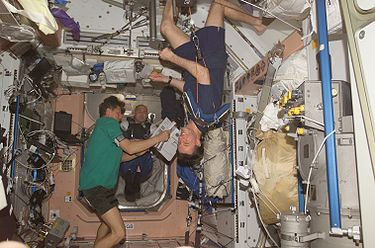
Weightlessnessis the complete or near-complete absence of the sensation ofweight,i.e., zeroapparent weight.It is also termedzero g-force,orzero-g(named after theg-force)[1]or, incorrectly,zero gravity.
Microgravity environmentis more or less synonymous in its effects, with the recognition that g-forces are never exactly zero.
Weight is a measurement of the force on an object at rest in a relatively strong gravitational field (such as on the surface of the Earth). These weight-sensations originate from contact with supporting floors, seats, beds, scales, and the like. A sensation of weight is also produced, even when the gravitational field is zero, when contact forces act upon and overcome a body'sinertiaby mechanical, non-gravitationalforces- such as in acentrifuge,a rotatingspace station,or within an accelerating vehicle.
When thegravitational fieldis non-uniform, a body infree fallexperiencestidal forcesand is not stress-free. Near ablack hole,such tidal effects can be very strong, meeting tospaghettification.In the case of the Earth, the effects are minor, especially on objects of relatively small dimensions (such as the human body or a spacecraft) and the overall sensation of weightlessness in these cases is preserved. This condition is known as microgravity, and it prevails in orbiting spacecraft.
Weightlessness in Newtonian mechanics[edit]
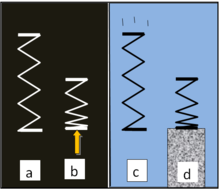
In Newtonian physics, the sensation of weightlessness experienced by astronauts is not the result of there being zero gravitational acceleration (as seen from the Earth), but of there being nog-forcethat an astronaut can feel because of the free-fall condition, and also there being zero difference between the acceleration of the spacecraft and the acceleration of the astronaut. Space journalistJames Obergexplains the phenomenon this way:[2]
The myth that satellites remain in orbit because they have "escaped Earth's gravity" is perpetuated further (and falsely) by almost universal misuse of the word "zero gravity" to describe the free-falling conditions aboard orbiting space vehicles. Of course, this isn't true; gravity still exists in space. It keeps satellites from flying straight off into interstellar emptiness. What's missing is "weight", the resistance of gravitational attraction by an anchored structure or a counterforce. Satellites stay in space because of their tremendous horizontal speed, which allows them—while being unavoidably pulled toward Earth by gravity—to fall "over the horizon." The ground's curved withdrawal along the Earth's round surface offsets the satellites' fall toward the ground. Speed, not position or lack of gravity, keeps satellites in orbit around the Earth.
From the perspective of an observer not moving with the object (i.e. in aninertial reference frame) the force of gravity on an object in free fall is exactly the same as usual.[3]A classic example is an elevator car where the cable has been cut and it plummets toward Earth, accelerating at a rate equal to the 9.81 meters per second per second. In this scenario, the gravitational force is mostly, but not entirely, diminished; anyone in the elevator would experience an absence of the usual gravitational pull, however the force is notexactlyzero. Since gravity is a force directed towards the center of the Earth, two balls a horizontal distance apart would be pulled in slightly different directions and would come closer together as the elevator dropped. Also, if they were some vertical distance apart the lower one would experience a higher gravitational force than the upper one since gravity diminishes according to theinverse square law.These two second-order effects are examples of micro gravity.[3]
Weightless and reduced weight environments[edit]
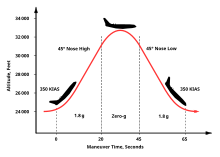
Reduced weight in aircraft[edit]
Airplanes have been used since 1959 to provide a nearly weightless environment in which to train astronauts, conduct research, and film motion pictures. Such aircraft are commonly referred by the nickname "Vomit Comet".
To create a weightless environment, the airplane flies in a 10 km (6 mi)parabolicarc, first climbing, then entering a powered dive. During the arc, the propulsion and steering of the aircraft are controlled to cancel thedrag(air resistance) on the plane out, leaving the plane to behave as if it were free-falling in a vacuum.

NASA's Reduced Gravity Aircraft[edit]
Versions of such airplanes have been operated byNASA's Reduced Gravity Research Program since 1973, where the unofficial nickname originated.[4]NASA later adopted the official nickname 'Weightless Wonder' for publication.[5]NASA's current Reduced Gravity Aircraft, "Weightless Wonder VI", aMcDonnell Douglas C-9,is based atEllington Field(KEFD), nearLyndon B. Johnson Space Center.
NASA'sMicrogravity University- Reduced Gravity Flight Opportunities Plan, also known as the Reduced Gravity Student Flight Opportunities Program, allows teams of undergraduates to submit a microgravity experiment proposal. If selected, the teams design and implement their experiment, and students are invited to fly on NASA's Vomit Comet.[citation needed]
European Space Agency A310 Zero-G[edit]
TheEuropean Space Agency(ESA) flies parabolic flights on a specially modifiedAirbus A310-300aircraft[6]to perform research in microgravity. Along with the FrenchCNESand the GermanDLR,they conductcampaignsof three flights over consecutive days, with each flight's about 30 parabolae totalling about 10 minutes of weightlessness. These campaigns are currently operated fromBordeaux - Mérignac AirportbyNovespace,[7]a subsidiary ofCNES;the aircraft is flown by test pilots fromDGA Essais en Vol.
As of May 2010[update],the ESA has flown 52 scientific campaigns and also 9 student parabolic flight campaigns.[8]Their first Zero-G flights were in 1984 using a NASA KC-135 aircraft inHouston,Texas. Other aircraft used include theRussianIlyushin Il-76MDK before founding Novespace, then a FrenchCaravelleand anAirbus A300 Zero-G.[9][10][11]
Commercial flights for public passengers[edit]
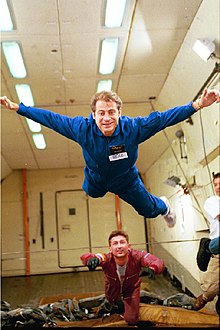
Novespace created Air Zero G in 2012 to share the experience of weightlessness with 40 public passengers per flight, using the same A310 ZERO-G as for scientific experiences.[12]These flights are sold byAvico,are mainly operated fromBordeaux-Merignac,France,and intend to promote European space research, allowing public passengers to feel weightlessness.Jean-François Clervoy,Chairman of Novespace andESAastronaut, flies with these one-day astronauts on board A310 Zero-G. After the flight, he explains the quest of space and talks about the 3 space travels he did along his career. The aircraft has also been used for cinema purposes, withTom CruiseandAnnabelle Wallisforthe Mummyin 2017.[13]
TheZero Gravity Corporationoperates a modifiedBoeing 727which flies parabolic arcs to create 25–30 seconds of weightlessness.
Ground-based drop facilities[edit]
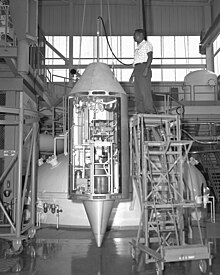
Ground-based facilities that produce weightless conditions for research purposes are typically referred to asdrop tubesor drop towers.
NASA'sZero Gravity Research Facility,located at theGlenn Research CenterinCleveland, Ohio,is a 145 m vertical shaft, largely below the ground, with an integral vacuum drop chamber, in which an experiment vehicle can have a free fall for a duration of 5.18 seconds, falling a distance of 132 m. The experiment vehicle is stopped in approximately 4.5 m ofpelletsof expandedpolystyrene,experiencing a peakdecelerationrate of 65g.
Also at NASA Glenn is the 2.2 Second Drop Tower, which has a drop distance of 24.1 m. Experiments are dropped in a drag shield in order to reduce the effects of air drag. The entire package is stopped in a 3.3 m tall air bag, at a peak deceleration rate of approximately 20g.While the Zero Gravity Facility conducts one or two drops per day, the 2.2 Second Drop Tower can conduct up to twelve drops per day.
NASA'sMarshall Space Flight Centerhosts another drop tube facility that is 105 m tall and provides a 4.6 s free fall under near-vacuumconditions.[14]
Other drop facilities worldwide include:
- Micro-Gravity Laboratory of Japan(MGLAB) – 4.5 s free fall
- Experimental drop tube of the metallurgy department ofGrenoble– 3.1 s free fall
- Fallturm BremenUniversity of BremeninBremen– 4.74 s free fall
- Queensland University of Technology Drop Tower – 2.0 s free fall
- National Centre for Combustion Research and Development atIIT-M– 2.5 s free fall[15]
Random Positioning Machines[edit]
Another ground-based approach to simulate weightlessness for biological sample is a "3D-clinostat," also called arandom positioning machine.Unlike a regularclinostat,the random positioning machine rotates in two axes simultaneously and progressively establishes a microgravity-like condition via the prinicple of gravity-vector-averaging.
Neutral buoyancy[edit]
This section is empty.You can help byadding to it.(November 2022) |
Orbits[edit]
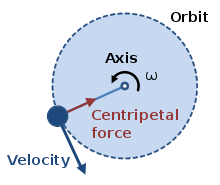
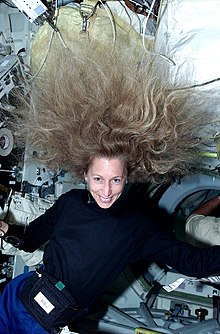

On theInternational Space Station (ISS),there are small g-forces come fromtidal effects,gravity from objects other than the Earth, such as astronauts, the spacecraft, and theSun,air resistance,and astronaut movements that impartmomentumto the space station).[16][17][18]The symbol for microgravity,μg,was used on the insignias ofSpace ShuttleflightsSTS-87andSTS-107,because these flights were devoted to microgravity research inlow Earth orbit.
Sub-Orbital flights[edit]
Over the years, biomedical research on the implications of space flight has become more prominent in evaluating possible pathophysiological changes in humans.[19]Sub-orbital flightsseize the approximated weightlessness, or μg, in thelow Earth orbitand represent a promising research model for short-term exposure. Examples of such approaches are theMASER,MAXUS,orTEXUSprogram run by theSwedish Space Corporationand theEuropean Space Agency.
Orbital Motion[edit]
Orbital motionis a form of free fall.[3]Objects in orbit are not perfectly weightless due to several effects:
- Effects depending on relative position in the spacecraft:
- Because the force of gravity decreases with distance, objects with non-zero size will be subjected to atidal force,or a differential pull, between the ends of the object nearest and furthest from the Earth. (An extreme version of this effect isspaghettification.) In a spacecraft inlow Earth orbit(LEO), thecentrifugal forceis also greater on the side of the spacecraft furthest from the Earth. At a 400 km LEO altitude, the overall differential in g-force is approximately 0.384 μg/m.[20][3]
- Gravity between the spacecraft and an object within it may make the object slowly "fall" toward a more massive part of it. The acceleration is 0.007 μgfor 1000 kg at 1 m distance.
- Uniform effects (which could be compensated):
- Though extremely thin, there is some air at orbital altitudes of 185 to 1,000 km. This atmosphere causes minuscule deceleration due to friction. This could be compensated by a small continuous thrust, but in practice the deceleration is only compensated from time to time, so the tiny g-force of this effect is not eliminated.
- The effects of thesolar windandradiation pressureare similar, but directed away from the Sun. Unlike the effect of the atmosphere, it does not reduce with altitude.
- Other Effects:
- Routine crew activity: Due to theconservation of momentum,any crew member aboard a spacecraft pushing off a wall causes the spacecraft to move in the opposite direction.
- Structural Vibration: Stress enacted on the hull of the spacecraft results in the spacecraft bending, causing apparent acceleration.
Weightlessness at the center of a planet[edit]
If an object were to travel to the center of a spherical planet unimpeded by the planet's materials, it would achieve a state of weightlessness upon arriving at the center of the planet'score.This is because the mass of the surrounding planet is exerting an equal gravitational pull in all directions from the center, canceling out the pull of any one direction, establishing a space with no gravitational pull.[21]
Absence of gravity[edit]
A "stationary" micro-g environment[22]would require travelling far enough into deep space so as to reduce the effect of gravity byattenuationto almost zero. This is simple in conception but requires travelling a very large distance, rendering it highly impractical. For example, to reduce the gravity of the Earth by a factor of one million, one needs to be at a distance of 6 million kilometres from the Earth, but to reduce the gravity of the Sun to this amount, one has to be at a distance of 3.7 billion kilometres. This is not impossible, but it has only been achieved thus far by fourinterstellar probes:(Voyager 1and2of theVoyager program,andPioneer 10and11of thePioneer program.) At thespeed of lightit would take roughly three and a half hours to reach this micro-gravity environment (a region of space where the acceleration due to gravity is one-millionth of that experienced on the Earth's surface). To reduce the gravity to one-thousandth of that on Earth's surface, however, one needs only to be at a distance of 200,000 km.
| Location | Gravity due to | Total | ||
|---|---|---|---|---|
| Earth | Sun | rest ofMilky Way | ||
| Earth's surface | 9.81 m/s2 | 6 mm/s2 | 200 pm/s2= 6 mm/s/yr | 9.81 m/s2 |
| Low Earth orbit | 9 m/s2 | 6 mm/s2 | 200 pm/s2 | 9 m/s2 |
| 200,000 km from Earth | 10 mm/s2 | 6 mm/s2 | 200 pm/s2 | up to 12 mm/s2 |
| 6×106kmfrom Earth | 10 μm/s2 | 6 mm/s2 | 200 pm/s2 | 6 mm/s2 |
| 3.7×109kmfrom Earth | 29 pm/s2 | 10 μm/s2 | 200 pm/s2 | 10 μm/s2 |
| Voyager 1(17×109kmfrom Earth) | 1 pm/s2 | 500 nm/s2 | 200 pm/s2 | 500 nm/s2 |
| 0.1light-yearfrom Earth | 400 am/s2 | 200 pm/s2 | 200 pm/s2 | up to 400 pm/s2 |
At a distance relatively close to Earth (less than 3000 km), gravity is only slightly reduced. As an object orbits a body such as the Earth, gravity is still attracting objects towards the Earth and the object is accelerated downward at almost 1g. Because the objects are typically moving laterally with respect to the surface at such immense speeds, the object will not lose altitude because of the curvature of the Earth. When viewed from an orbiting observer, other close objects in space appear to be floating because everything is being pulled towards Earth at the same speed, but also moving forward as the Earth's surface "falls" away below. All these objects are infree fall,not zero gravity.
Compare thegravitational potential at some of these locations.
Health effects[edit]

Following the advent ofspace stationsthat can be inhabited for long periods, exposure to weightlessness has been demonstrated to have some deleterious effects on human health.[23][24]Humans are well-adapted to the physical conditions at the surface of the Earth. In response to an extended period of weightlessness, various physiological systems begin to change and atrophy. Though these changes are usually temporary, long term health issues can result.
The most common problem experienced by humans in the initial hours of weightlessness is known asspace adaptation syndromeor SAS, commonly referred to as space sickness. Symptoms of SAS includenauseaandvomiting,vertigo,headaches,lethargy,and overall malaise.[25]The first case of SAS was reported bycosmonautGherman Titovin 1961. Since then, roughly 45% of all people who have flown in space have suffered from this condition. The duration of space sickness varies, but in no case has it lasted for more than 72 hours, after which the body adjusts to the new environment.NASAjokingly measures SAS using the "Garn scale", named forUnited States SenatorJake Garn,whose SAS duringSTS-51-Dwas the worst on record. Accordingly, one "Garn" is equivalent to the most severe possible case of SAS.[26]
The most significant adverse effects of long-term weightlessness aremuscle atrophy(seeReduced muscle mass, strength and performance in spacefor more information) and deterioration of theskeleton,orspaceflight osteopenia.[25]These effects can be minimized through a regimen of exercise,[27]such as cycling for example. Astronauts subject to long periods of weightlessness wear pants with elastic bands attached between waistband and cuffs to compress the leg bones and reduce osteopenia.[28]Other significant effects include fluid redistribution (causing the "moon-face" appearance typical of pictures of astronauts in weightlessness),[28][29]changes in thecardiovascular systemas blood pressures and flow velocities change in response to a lack of gravity, a decreased production ofred blood cells,balance disorders, and a weakening of theimmune system.[30]Lesser symptoms include loss of body mass, nasal congestion, sleep disturbance, excessflatulence,and puffiness of the face. These effects begin to reverse quickly upon return to the Earth.
In addition, after longspace flightmissions, astronauts may experiencevisionchanges.[31][32][33][34][35]Such eyesight problems may be a major concern for future deep space flight missions, including acrewed missionto the planetMars.[31][32][33][34][36]Exposure to high levels of radiation may influence the development of atherosclerosis.[37]Clots in the internal jugular vein have recently been detected inflight.[38]
On December 31, 2012, aNASA-supported study reported thathuman spaceflightmay harm thebrainsofastronautsand accelerate the onset ofAlzheimer's disease.[39][40][41]In October 2015, theNASA Office of Inspector Generalissued ahealth hazards reportrelated tohuman spaceflight,including ahuman missiontoMars.[42][43]
Space motion sickness[edit]

Space motion sickness(SMS) is thought to be a subtype ofmotion sicknessthat plagues nearly half of all astronauts who venture into space.[44]SMS, along with facial stuffiness from headward shifts of fluids, headaches, and back pain, is part of a broader complex of symptoms that comprisespace adaptation syndrome(SAS).[45]SMS was first described in 1961 during the second orbit of the fourth crewed spaceflight when the cosmonautGherman Titovaboard theVostok 2,described feeling disoriented with physical complaints mostly consistent with motion sickness. It is one of the most studied physiological problems of spaceflight but continues to pose a significant difficulty for many astronauts. In some instances, it can be so debilitating that astronauts must sit out from their scheduled occupational duties in space – including missing out on a spacewalk they have spent months training to perform.[46]In most cases, however, astronauts will work through the symptoms even with degradation in their performance.[47]
Despite their experiences in some of the most rigorous and demanding physical maneuvers on earth, even the most seasoned astronauts may be affected by SMS, resulting in symptoms of severenausea,projectilevomiting,fatigue,malaise (feeling sick), andheadache.[47]These symptoms may occur so abruptly and without any warning that space travelers may vomit suddenly without time to contain the emesis, resulting in strong odors and liquid within the cabin which may affect other astronauts.[47]Some changes to eye movement behaviors might also occur as a result of SMS.[48]Symptoms typically last anywhere from one to three days upon entering weightlessness, but may recur upon reentry to Earth's gravity or even shortly after landing. SMS differs from terrestrial motion sickness in that sweating and pallor are typically minimal or absent and gastrointestinal findings usually demonstrate absent bowel sounds indicating reducedgastrointestinal motility.[49]
Even when the nausea and vomiting resolve, some central nervous system symptoms may persist which may degrade the astronaut's performance.[49]Graybiel and Knepton proposed the term "sopite syndrome"to describe symptoms of lethargy and drowsiness associated with motion sickness in 1976.[50]Since then, their definition has been revised to include "...a symptom complex that develops as a result of exposure to real or apparent motion and is characterized by excessive drowsiness, lassitude, lethargy, mild depression, and reduced ability to focus on an assigned task."[51]Together, these symptoms may pose a substantial threat (albeit temporary) to the astronaut who must remain attentive to life and death issues at all times.
SMS is most commonly thought to be a disorder of thevestibular systemthat occurs when sensory information from the visual system (sight) and theproprioceptivesystem (posture, position of the body) conflicts with misperceived information from the semicircular canals and the otoliths within the inner ear. This is known as the 'neural mismatch theory' and was first suggested in 1975 by Reason and Brand.[52]Alternatively, the fluid shift hypothesis suggests that weightlessness reduces the hydrostatic pressure on the lower body causing fluids to shift toward the head from the rest of the body. These fluid shifts are thought to increase cerebrospinal fluid pressure (causing back aches), intracranial pressure (causing headaches), and inner ear fluid pressure (causing vestibular dysfunction).[53]
Despite a multitude of studies searching for a solution to the problem of SMS, it remains an ongoing problem for space travel. Most non-pharmacological countermeasures such as training and other physical maneuvers have offered minimal benefit. Thornton and Bonato noted, "Pre- and inflight adaptive efforts, some of them mandatory and most of them onerous, have been, for the most part, operational failures."[54]To date, the most common intervention ispromethazine,an injectableantihistaminewithantiemeticproperties, but sedation can be a problematic side effect.[55]Other common pharmacological options includemetoclopramide,as well as oral and transdermal application ofscopolamine,but drowsiness and sedation are common side effects for these medications as well.[53]
Musculoskeletal effects[edit]
In the space (or microgravity) environment the effects of unloading varies significantly among individuals, with sex differences compounding the variability.[56]Differences in mission duration, and the small sample size of astronauts participating in the same mission also adds to the variability to themusculoskeletal disordersthat are seen in space.[57]In addition to muscle loss, microgravity leads to increasedbone resorption,decreasedbone mineral density,and increased fracture risks. Bone resorption leads to increased urinary levels ofcalcium,which can subsequently lead to an increased risk ofnephrolithiasis.[58]
In the first two weeks that the muscles are unloaded from carrying the weight of the human frame during space flight, whole muscle atrophy begins. Postural muscles contain more slow fibers, and are more prone to atrophy than non-postural muscle groups.[57]The loss of muscle mass occurs because of imbalances in protein synthesis and breakdown. The loss of muscle mass is also accompanied by a loss of muscle strength, which was observed after only 2–5 days of spaceflight during theSoyuz-3andSoyuz-8missions.[57]Decreases in the generation of contractile forces and whole muscle power have also been found in response to microgravity.
To counter the effects of microgravity on the musculoskeletal system, aerobic exercise is recommended. This often takes the form of in-flight cycling.[57]A more effective regimen includes resistive exercises or the use of a penguin suit[57](contains sewn-in elastic bands to maintain a stretch load on antigravity muscles), centrifugation, and vibration.[58]Centrifugation recreates Earth's gravitational force on the space station, in order to preventmuscle atrophy.Centrifugation can be performed with centrifuges or by cycling along the inner wall of the space station.[57]Whole body vibration has been found to reduce bone resorption through mechanisms that are unclear. Vibration can be delivered using exercise devices that use vertical displacements juxtaposed to a fulcrum, or by using a plate that oscillates on a vertical axis.[59]The use ofbeta-2 adrenergic agoniststo increase muscle mass, and the use of essential amino acids in conjunction with resistive exercises have been proposed as pharmacologic means of combating muscle atrophy in space.[57]
Cardiovascular effects[edit]
Next to the skeletal and muscular system, the cardiovascular system is less strained in weightlessness than on Earth and is de-conditioned during longer periods spent in space.[60]In a regular environment, gravity exerts a downward force, setting up a vertical hydrostatic gradient. When standing, some 'excess' fluid resides in vessels and tissues of the legs. In a micro-g environment, with the loss of ahydrostatic gradient,some fluid quickly redistributes toward the chest and upper body; sensed as 'overload' of circulating blood volume.[61]In the micro-g environment, the newly sensed excess blood volume is adjusted by expelling excess fluid into tissues and cells (12-15% volume reduction) andred blood cellsare adjusted downward to maintain a normal concentration (relativeanemia).[61]In the absence of gravity, venous blood will rush to theright atriumbecause the force of gravity is no longer pulling the blood down into the vessels of the legs and abdomen, resulting in increasedstroke volume.[62]These fluid shifts become more dangerous upon returning to a regular gravity environment as the body will attempt to adapt to the reintroduction of gravity. The reintroduction of gravity again will pull the fluid downward, but now there would be a deficit in both circulating fluid and red blood cells. The decrease in cardiac filling pressure and stroke volume during the orthostatic stress due to a decreased blood volume is what causesorthostatic intolerance.[63]Orthostatic intolerance can result in temporary loss of consciousness and posture, due to the lack of pressure and stroke volume.[64]Some animal species have evolved physiological and anatomical features (such as high hydrostatic blood pressure and closer heart place to head) which enable them to counteract orthostatic blood pressure.[65][66]More chronic orthostatic intolerance can result in additional symptoms such asnausea,sleep problems,and other vasomotor symptoms as well.[67]
Many studies on the physiological effects of weightlessness on the cardiovascular system are done in parabolic flights. It is one of the only feasible options to combine with human experiments, making parabolic flights the only way to investigate the true effects of the micro-g environment on a body without traveling into space.[68]Parabolic flight studies have provided a broad range of results regarding changes in the cardiovascular system in a micro-g environment. Parabolic flight studies have increased the understanding of orthostatic intolerance and decreased peripheral blood flow suffered by astronauts returning to Earth. Due to the loss of blood to pump, the heart can atrophy in a micro-g environment. A weakened heart can result in low blood volume, low blood pressure and affect the body's ability to send oxygen to the brain without the individual becoming dizzy.[69]Heart rhythm disturbanceshave also been seen among astronauts, but it is unclear whether this was a result of pre-existing conditions or an effect of the micro-g environment.[70]One current countermeasure includes drinking a salt solution, which increases the viscosity of blood and would subsequently increase blood pressure, which would mitigate post micro-g environment orthostatic intolerance. Another countermeasure includes administration ofmidodrine,which is a selectiveAlpha -1adrenergic agonist. Midodrine produces arterial and venous constriction resulting in an increase in blood pressure bybaroreceptor reflexes.[71]
Effects on non-human organisms[edit]
Russian scientists have observed differences between cockroaches conceived in space and their terrestrial counterparts. The space-conceived cockroaches grew more quickly, and also grew up to be faster and tougher.[72]
Chicken eggs that are put in microgravity two days after fertilization appear not to develop properly, whereas eggs put in microgravity more than a week after fertilization develop normally.[73]
A 2006 Space Shuttle experiment found thatSalmonella typhimurium,a bacterium that can cause food poisoning, became more virulent when cultivated in space.[74]On April 29, 2013, scientists in Rensselaer Polytechnic Institute, funded byNASA,reported that, duringspaceflighton theInternational Space Station,microbesseem to adapt to thespace environmentin ways "not observed on Earth" and in ways that "can lead to increases in growth andvirulence".[75]
Under certain test conditions, microbes have been observed to thrive in the near-weightlessness of space[76]and tosurvive in the vacuum of outer space.[77][78]
Commercial applications[edit]
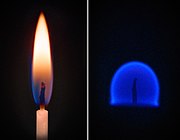
High-quality crystals[edit]
While not yet a commercial application, there has been interest in growingcrystalsin micro-g, as in aspace stationor automated artificialsatellite,in an attempt to reduce crystal lattice defects.[79]Such defect-free crystals may prove useful for certain microelectronic applications and also to produce crystals for subsequentX-ray crystallography.
In 2017, an experiment on the ISS was conducted to crystallize themonoclonal antibodytherapeuticPembrolizumab,where results showed more uniform and homogenous crystal particles compared to ground controls.[80]Such uniform crystal particles can allow for the formulation of more concentrated, low-volume antibody therapies, something which can make them suitable forsubcutaneous administration,a less invasive approach compared to the current prevalent method ofintravenousadministration.[81]
-
Comparison of boiling of water under Earth's gravity (1 g, left) and microgravity (right). The source of heat is in the lower part of the photograph.
-
Comparison ofinsulincrystals growth in outer space (left) and on Earth (right).
-
Liquids may also behave differently than on Earth, as demonstrated in this video
See also[edit]
- Artificial gravity
- Astronauts
- Clinostat
- Commercial use of space
- Effect of spaceflight on the human body
- ESA Scientific Research on the International Space Station
- European Low Gravity Research Association(ELGRA)
- G-jitter
- Microgravity University
- Reduced-gravity aircraft
- Scientific research on the International Space Station
- Space adaptation syndrome
- Space manufacturing
- Space medicine
- Vomit Comet
References[edit]
- ^"Weightlessness and Its Effect on Astronauts".Space.16 December 2017.
The sensation of weightlessness, or zero gravity, happens when the effects of gravity are not felt.
- ^Oberg, James(May 1993)."Space myths and misconceptions".Omni.15(7).Archivedfrom the original on 2007-09-27.Retrieved2007-05-02.
- ^abcdChandler, David (May 1991)."Weightlessness and Microgravity"(PDF).The Physics Teacher.29(5): 312–13.Bibcode:1991PhTea..29..312C.doi:10.1119/1.2343327.
- ^Reduced Gravity Research Program
- ^"Loading..."nasaexplores.Retrieved24 April2018.
- ^"Zero-G flying means high stress for an old A310".Flightglobal.2015-03-23.Archivedfrom the original on 2017-08-21.Retrieved2017-08-23.
- ^"Novespace: microgravity, airborne missions".novespace.Archivedfrom the original on 31 March 2018.Retrieved24 April2018.
- ^European Space Agency."Parabolic Flight Campaigns".ESA Human Spaceflight web site.Archivedfrom the original on 2012-05-26.Retrieved2011-10-28.
- ^European Space Agency."A300 Zero-G".ESA Human Spaceflight web site.Retrieved2006-11-12.
- ^European Space Agency."Next campaign".ESA Human Spaceflight web site.Retrieved2006-11-12.
- ^European Space Agency."Campaign Organisation".ESA Human Spaceflight web site.Retrieved2006-11-12.
- ^"French astronaut performs" Moonwalk "on parabolic flight - Air & Cosmos - International".Air & Cosmos - International.Archivedfrom the original on 2017-08-21.Retrieved2017-08-23.
- ^"Tom Cruise defies gravity in Novespace ZERO-G A310".Archivedfrom the original on 2017-08-21.Retrieved2017-08-23.
- ^"Marshall Space Flight Center Drop Tube Facility".nasa.gov.Archived fromthe originalon 19 September 2000.Retrieved24 April2018.
- ^Kumar, Amit (2018)."The 2.5 s Microgravity Drop Tower at National Centre for Combustion Research and Development (NCCRD), Indian Institute of Technology Madras".Microgravity Science and Technology.30(5): 663–673.Bibcode:2018MicST..30..663V.doi:10.1007/s12217-018-9639-0.
- ^Chandler, David (May 1991)."Weightlessness and Microgravity"(PDF).The Physics Teacher.29(5): 312–13.Bibcode:1991PhTea..29..312C.doi:10.1119/1.2343327.
- ^Karthikeyan KC (September 27, 2015)."What Are Zero Gravity and Microgravity, and What Are the Sources of Microgravity?".Geekswipe.Retrieved17 April2019.
- ^Oberg, James (May 1993)."Space myths and misconceptions – space flight".OMNI.15(7): 38ff.
- ^Afshinnekoo, Ebrahim; Scott, Ryan T.; MacKay, Matthew J.; Pariset, Eloise; Cekanaviciute, Egle; Barker, Richard; Gilroy, Simon; Hassane, Duane; Smith, Scott M.; Zwart, Sara R.; Nelman-Gonzalez, Mayra; Crucian, Brian E.; Ponomarev, Sergey A.; Orlov, Oleg I.; Shiba, Dai (November 2020)."Fundamental Biological Features of Spaceflight: Advancing the Field to Enable Deep-Space Exploration".Cell.183(5): 1162–1184.doi:10.1016/j.cell.2020.10.050.ISSN0092-8674.PMC8441988.PMID33242416.
- ^Bertrand, Reinhold (1998).Conceptual Design and Flight Simulation of Space Stations.Herbert Utz Verlag. p. 57.ISBN9783896755001.
- ^Baird, Christopher S. (4 October 2013)."What would happen if you fell into a hole that went through the center of the earth?".Science Questions with Surprising Answers.Retrieved8 May2024.
- ^Depending on distance, "stationary" is meant relative to Earth or the Sun.
- ^Chang, Kenneth (27 January 2014)."Beings Not Made for Space".New York Times.Archivedfrom the original on 28 January 2014.Retrieved27 January2014.
- ^Stepanek, Jan; Blue, Rebecca S.; Parazynski, Scott (2019-03-14). Longo, Dan L. (ed.)."Space Medicine in the Era of Civilian Spaceflight".New England Journal of Medicine.380(11): 1053–1060.doi:10.1056/NEJMra1609012.ISSN0028-4793.PMID30865799.S2CID76667295.
- ^abKanas, Nick; Manzey, Dietrich (2008). "Basic Issues of Human Adaptation to Space Flight".Space Psychology and Psychiatry.Space Technology Library. Vol. 22. pp. 15–48.Bibcode:2008spp..book.....K.doi:10.1007/978-1-4020-6770-9_2.ISBN978-1-4020-6769-3.
- ^"NASA - Johnson Space Center History"(PDF).Archived(PDF)from the original on 2012-04-06.Retrieved2012-05-10.,pg 35, Johnson Space Center Oral History Project, interview with Dr. Robert Stevenson:
"Jake Garn was sick, was pretty sick. I don't know whether we should tell stories like that. But anyway, Jake Garn, he has made a mark in the Astronaut Corps because he represents the maximum level of space sickness that anyone can ever attain, and so the mark of being totally sick and totally incompetent is one Garn. Most guys will get maybe to a tenth Garn, if that high. And within the Astronaut Corps, he forever will be remembered by that."
- ^Kelly, Scott(2017).Endurance: A Year in Space, a Lifetime of Discovery.With Margaret Lazarus Dean. Alfred A. Knopf, a division of Penguin Random House. p. 174.ISBN9781524731595.
One of the nice things about living in space is that exercise is part of your job... If I don't exercise six days a week for at least a couple of hours a day, my bones will lose significant mass - 1 percent each month... Our bodies are smart about getting rid of what's not needed, and my body has started to notice that my bones are not needed in zero gravity. Not having to support our weight, we lose muscle as well.
- ^ab"Health FitnessArchived2012-05-19 at theWayback Machine",Space Future
- ^"The Pleasure of SpaceflightArchived2012-02-21 at theWayback Machine",Toyohiro Akiyama,Journal of Space Technology and Science,Vol.9 No.1 spring 1993, pp.21-23
- ^Buckey, Jay C. (2006).Space Physiology.Oxford University Press.ISBN978-0-19-513725-5.
- ^abMader, T. H.; et al. (2011)."Optic Disc Edema, Globe Flattening, Choroidal Folds, and Hyperopic Shifts Observed in Astronauts after Long-duration Space Flight".Ophthalmology.118(10): 2058–2069.doi:10.1016/j.ophtha.2011.06.021.PMID21849212.S2CID13965518.
- ^abPuiu, Tibi (November 9, 2011)."Astronauts' vision severely affected during long space missions".zmescience.Archivedfrom the original on November 10, 2011.RetrievedFebruary 9,2012.
- ^ab"Video News - CNN".CNN.Archivedfrom the original on 4 February 2009.Retrieved24 April2018.
- ^abSpace Staff (13 March 2012)."Spaceflight Bad for Astronauts' Vision, Study Suggests".Space.Archivedfrom the original on 13 March 2012.Retrieved14 March2012.
- ^Kramer, Larry A.; et al. (13 March 2012)."Orbital and Intracranial Effects of Microgravity: Findings at 3-T MR Imaging".Radiology.263(3): 819–827.doi:10.1148/radiol.12111986.PMID22416248.Retrieved14 March2012.
- ^Fong, MD, Kevin (12 February 2014)."The Strange, Deadly Effects Mars Would Have on Your Body".Wired.Archivedfrom the original on 14 February 2014.Retrieved12 February2014.
- ^Abbasi, Jennifer (20 December 2016). "Do Apollo Astronaut Deaths Shine a Light on Deep Space Radiation and Cardiovascular Disease?".JAMA.316(23): 2469–2470.doi:10.1001/jama.2016.12601.PMID27829076.
- ^Auñón-Chancellor, Serena M.; Pattarini, James M.; Moll, Stephan; Sargsyan, Ashot (2020-01-02)."Venous Thrombosis during Spaceflight".New England Journal of Medicine.382(1): 89–90.doi:10.1056/NEJMc1905875.ISSN0028-4793.
- ^Cherry, Jonathan D.; Frost, Jeffrey L.; Lemere, Cynthia A.; Williams, Jacqueline P.; Olschowka, John A.; O'Banion, M. Kerry (2012)."Galactic Cosmic Radiation Leads to Cognitive Impairment and Increased Aβ Plaque Accumulation in a Mouse Model of Alzheimer's Disease".PLOS ONE.7(12): e53275.Bibcode:2012PLoSO...753275C.doi:10.1371/journal.pone.0053275.PMC3534034.PMID23300905.
- ^Staff (January 1, 2013)."Study Shows that Space Travel is Harmful to the Brain and Could Accelerate Onset of Alzheimer's".SpaceRef.RetrievedJanuary 7,2013.
- ^Cowing, Keith(January 3, 2013)."Important Research Results NASA Is Not Talking About (Update)".NASA Watch.RetrievedJanuary 7,2013.
- ^Dunn, Marcia (October 29, 2015)."Report: NASA needs better handle on health hazards for Mars".AP News.Archivedfrom the original on October 30, 2015.RetrievedOctober 30,2015.
- ^Staff (October 29, 2015)."NASA's Efforts to Manage Health and Human Performance Risks for Space Exploration (IG-16-003)"(PDF).NASA.Archived(PDF)from the original on October 30, 2015.RetrievedOctober 29,2015.
- ^Weerts, Aurélie P.; Vanspauwen, Robby; Fransen, Erik; Jorens, Philippe G.; Van de Heyning, Paul H.; Wuyts, Floris L. (2014-06-01). "Space Motion Sickness Countermeasures: A Pharmacological Double-Blind, Placebo-Controlled Study".Aviation, Space, and Environmental Medicine.85(6): 638–644.doi:10.3357/asem.3865.2014.PMID24919385.
- ^"Space Motion Sickness (Space Adaptation)"(PDF).NASA.June 15, 2016.RetrievedNovember 25,2017.
- ^"Illness keeps astronaut from spacewalk".ABCNews.February 12, 2008.RetrievedNovember 25,2017.
- ^abcThornton, William; Bonato, Frederick (2017).The Human Body and Weightlessness.SpringerLink. p. 32.doi:10.1007/978-3-319-32829-4.ISBN978-3-319-32828-7.
- ^Alexander, Robert G.; Macknik, Stephen L.; Martinez-Conde, Susana (2019)."Microsaccades in Applied Environments: Real-World Applications of Fixational Eye Movement Measurements".Journal of Eye Movement Research.12(6).doi:10.16910/jemr.12.6.15.PMC7962687.PMID33828760.
- ^abWotring, V. E. (2012).Space Pharmacology.Boston: Springer. p. 52.ISBN978-1-4614-3396-5.
- ^Graybiel, A; Knepton, J (August 1976). "Sopite syndrome: a sometimes sole manifestation of motion sickness".Aviation, Space, and Environmental Medicine.47(8): 873–882.PMID949309.
- ^Matsangas, Panagiotis; McCauley, Michael E. (June 2014). "Sopite Syndrome: A Revised Definition".Aviation, Space, and Environmental Medicine.85(6): 672–673.doi:10.3357/ASEM.3891.2014.PMID24919391.S2CID36203751.
- ^T., Reason, J. (1975).Motion sickness.Brand, J. J. London: Academic Press.ISBN978-0125840507.OCLC2073893.
{{cite book}}:CS1 maint: multiple names: authors list (link) - ^abHeer, Martina; Paloski, William H. (2006). "Space motion sickness: Incidence, etiology, and countermeasures".Autonomic Neuroscience.129(1–2): 77–79.doi:10.1016/j.autneu.2006.07.014.PMID16935570.S2CID6520556.
- ^Thornton, William; Bonato, Frederick (2017).The Human Body and Weightlessness.doi:10.1007/978-3-319-32829-4.ISBN978-3-319-32828-7.
- ^Space Pharmacology | Virginia E. Wotring.SpringerBriefs in Space Development. Springer. 2012. p. 59.doi:10.1007/978-1-4614-3396-5.ISBN978-1-4614-3395-8.
- ^Ploutz-Snyder, Lori; Bloomfield, Susan; Smith, Scott M.; Hunter, Sandra K.; Templeton, Kim; Bemben, Debra (November 2014)."Effects of Sex and Gender on Adaptation to Space: Musculoskeletal Health".Journal of Women's Health.23(11): 963–966.doi:10.1089/jwh.2014.4910.PMC4235589.PMID25401942.
- ^abcdefgNarici, M. V.; de Boer, M. D. (March 2011). "Disuse of the musculo-skeletal system in space and on earth".European Journal of Applied Physiology.111(3): 403–420.doi:10.1007/s00421-010-1556-x.PMID20617334.S2CID25185533.
- ^abSmith, Scott M.; Heer, Martina; Shackelford, Linda C.; Sibonga, Jean D.; Spatz, Jordan; Pietrzyk, Robert A.; Hudson, Edgar K.; Zwart, Sara R. (2015). "Bone metabolism and renal stone risk during International Space Station missions".Bone.81:712–720.doi:10.1016/j.bone.2015.10.002.PMID26456109.
- ^Elmantaser, M; McMillan, M; Smith, K; Khanna, S; Chantler, D; Panarelli, M; Ahmed, SF (September 2012). "A comparison of the effect of two types of vibration exercise on the endocrine and musculoskeletal system".Journal of Musculoskeletal & Neuronal Interactions.12(3): 144–154.PMID22947546.
- ^Ramsdell, Craig D.; Cohen, Richard J. (2003). "Cardiovascular System in Space".Encyclopedia of Space Science and Technology.doi:10.1002/0471263869.sst074.ISBN978-0-471-26386-9.
- ^abWhite, Ronald J.; Lujan, Barbara F. (1989).Current status and future direction of NASA's Space Life Sciences Program(Report).
- ^Aubert, André E.; Beckers, Frank; Verheyden, Bart; Plester, Vladimir (August 2004)."What happens to the human heart in space? - Parabolic flights provide some answers"(PDF).ESA Bulletin.119:30–38.Bibcode:2004ESABu.119...30A.
- ^Wieling, Wouter; Halliwill, John R.; Karemaker, John M. (January 2002)."Orthostatic intolerance after space flight".The Journal of Physiology.538(1): 1.doi:10.1113/jphysiol.2001.013372.PMC2290012.PMID11773310.
- ^Stewart, J. M. (May 2013)."Common Syndromes of Orthostatic Intolerance".Pediatrics.131(5): 968–980.doi:10.1542/peds.2012-2610.PMC3639459.PMID23569093.
- ^Lillywhite, Harvey B. (1993). "Orthostatic Intolerance of Viperid Snakes".Physiological Zoology.66(6): 1000–1014.doi:10.1086/physzool.66.6.30163751.JSTOR30163751.S2CID88375293.
- ^Nasoori, Alireza; Taghipour, Ali; Shahbazzadeh, Delavar; Aminirissehei, Abdolhossein; Moghaddam, Sharif (September 2014)."Heart place and tail length evaluation in Naja oxiana, Macrovipera lebetina, and Montivipera latifii".Asian Pacific Journal of Tropical Medicine.7:S137–S142.doi:10.1016/S1995-7645(14)60220-0.PMID25312108.
- ^Stewart, Julian M. (December 2004)."Chronic orthostatic intolerance and the postural tachycardia syndrome (POTS)".The Journal of Pediatrics.145(6): 725–730.doi:10.1016/j.jpeds.2004.06.084.PMC4511479.PMID15580191.
- ^Gunga, Hanns-Christian; Ahlefeld, Victoria Weller von; Coriolano, Hans-Joachim Appell; Werner, Andreas; Hoffmann, Uwe (2016-07-14).Cardiovascular system, red blood cells, and oxygen transport in microgravity.Gunga, Hanns-Christian,, Ahlefeld, Victoria Weller von,, Coriolano, Hans-Joachim Appell,, Werner, Andreas,, Hoffmann, Uwe. Switzerland.ISBN9783319332260.OCLC953694996.
{{cite book}}:CS1 maint: location missing publisher (link)[page needed] - ^Bungo, Michael (March 23, 2016)."Cardiac Atrophy and Diastolic Dysfunction During and After Long Duration Spaceflight: Functional Consequences for Orthostatic Intolerance, Exercise Capability and Risk for Cardiac Arrhythmias (Integrated Cardiovascular)".NASA.RetrievedNovember 25,2017.
- ^Fritsch-Yelle, Janice M.; Leuenberger, Urs A.; D’Aunno, Dominick S.; Rossum, Alfred C.; Brown, Troy E.; Wood, Margie L.; Josephson, Mark E.; Goldberger, Ary L. (June 1998). "An Episode of Ventricular Tachycardia During Long-Duration Spaceflight".The American Journal of Cardiology.81(11): 1391–1392.doi:10.1016/s0002-9149(98)00179-9.PMID9631987.
- ^Clément, Gilles (2011).Fundamentals of Space Medicine.Springer Science & Business Media.ISBN978-1-4419-9905-4.OCLC768427940.[page needed]
- ^"Mutant super-cockroaches from space".New Scientist. January 21, 2008.Archivedfrom the original on June 4, 2016.
- ^"Egg Experiment in Space Prompts Questions".New York Times.1989-03-31.Archivedfrom the original on 2009-01-21.
- ^Caspermeyer, Joe (23 September 2007)."Space flight shown to alter ability of bacteria to cause disease".Arizona State University.Archivedfrom the original on 14 September 2017.Retrieved14 September2017.
- ^Kim W, et al. (April 29, 2013)."Spaceflight Promotes Biofilm Formation by Pseudomonas aeruginosa".PLOS ONE.8(4): e6237.Bibcode:2013PLoSO...862437K.doi:10.1371/journal.pone.0062437.PMC3639165.PMID23658630.
- ^Dvorsky, George (13 September 2017)."Alarming Study Indicates Why Certain Bacteria Are More Resistant to Drugs in Space".Gizmodo.Archivedfrom the original on 14 September 2017.Retrieved14 September2017.
- ^Dose, K.; Bieger-Dose, A.; Dillmann, R.; Gill, M.; Kerz, O.; Klein, A.; Meinert, H.; Nawroth, T.; Risi, S.; Stridde, C. (1995). "ERA-experiment" space biochemistry "".Advances in Space Research.16(8): 119–129.Bibcode:1995AdSpR..16h.119D.doi:10.1016/0273-1177(95)00280-R.PMID11542696.
- ^Horneck G.; Eschweiler, U.; Reitz, G.; Wehner, J.; Willimek, R.; Strauch, K. (1995). "Biological responses to space: results of the experiment" Exobiological Unit "of ERA on EURECA I".Adv. Space Res.16(8): 105–18.Bibcode:1995AdSpR..16h.105H.doi:10.1016/0273-1177(95)00279-N.PMID11542695.
- ^"Growing Crystals in Zero-Gravity".
- ^"Published Results From Crystallization Experiments on the ISS Could Help Merck Improve Cancer Drug Delivery".
- ^Reichert, Paul; Prosise, Winifred; Fischmann, Thierry O.; Scapin, Giovanna; Narasimhan, Chakravarthy; Spinale, April; Polniak, Ray; Yang, Xiaoyu; Walsh, Erika; Patel, Daya; Benjamin, Wendy; Welch, Johnathan; Simmons, Denarra; Strickland, Corey (2019-12-02)."Pembrolizumab microgravity crystallization experimentation".npj Microgravity.5(1). Springer Science and Business Media LLC: 28.Bibcode:2019npjMG...5...28R.doi:10.1038/s41526-019-0090-3.ISSN2373-8065.PMC6889310.PMID31815178.
- ^Koszelak, S; Leja, C; McPherson, A (1996). "Crystallization of biological macromolecules from flash frozen samples on the Russian Space Station Mir".Biotechnology and Bioengineering.52(4): 449–58.doi:10.1002/(SICI)1097-0290(19961120)52:4<449::AID-BIT1>3.0.CO;2-P.PMID11541085.S2CID36939988.
External links[edit]
![]() The dictionary definition ofzero gravityat Wiktionary
The dictionary definition ofzero gravityat Wiktionary
![]() Media related toWeightlessnessat Wikimedia Commons
Media related toWeightlessnessat Wikimedia Commons
- Microgravity CentreArchived2011-07-26 at theWayback Machine
- How Weightlessness WorksatHowStuffWorks
- NASA - SpaceResearch - Human Physiology Research and the ISS: Staying Fit Along the Journey
- "Why are astronauts weightless?"Video explanation of the fallacy of" zero gravity ".
- Overview of microgravity applications and methods
- Criticism of the terms "Zero Gravity" and "Microgravity",a persuasion to use terminology that reflects accurate physics (sci.space post).
- Microgravity Collection, The University of Alabama in Huntsville Archives and Special Collections
- Space Biology Research at AU-KBC Research Centre
- Jhala, Dhwani; Kale, Raosaheb; Singh, Rana (2014). "Microgravity Alters Cancer Growth and Progression".Current Cancer Drug Targets.14(4): 394–406.doi:10.2174/1568009614666140407113633.PMID24720362.
- Tirumalai, Madhan R.; Karouia, Fathi; Tran, Quyen; Stepanov, Victor G.; Bruce, Rebekah J.; Ott, C. Mark; Pierson, Duane L.; Fox, George E. (December 2017)."The adaptation of Escherichia coli cells grown in simulated microgravity for an extended period is both phenotypic and genomic".npj Microgravity.3(1): 15.doi:10.1038/s41526-017-0020-1.PMC5460176.PMID28649637.


![Protein crystals grown by American scientists on the Russian Space Station Mir in 1995.[82]](https://upload.wikimedia.org/wikipedia/commons/thumb/d/d1/Crystals_grown_in_microgravity.jpg/120px-Crystals_grown_in_microgravity.jpg)
